Balkan Blues; the story of Serbia's struggle for supremacy
- Thread starter gremlok
- Start date
-
We have updated our Community Code of Conduct. Please read through the new rules for the forum that are an integral part of Paradox Interactive’s User Agreement.
You are using an out of date browser. It may not display this or other websites correctly.
You should upgrade or use an alternative browser.
You should upgrade or use an alternative browser.
You didnt want to take your corse from Austria while they are too busy with NGF?
I did consider it, but didn't want to pass on the CB on Bosnia. Besides I have build up 200 in relations to Austria, yet they keep refusing an alliance, and I got the likelihood 'Impossible' of Russia joining me against Austria. And as NGF just lost Wallonia to France I expected a fairly uneven fight.
Good luck! The upside to the Ottomans being a GP is that France can no longer intervene on their side due to 'friendly' relations. This looks like a great opportunity to make up for the last war.
I'm in. Is there a Yugoslavia decision?
He's got cores on all of Yugoslavia, so why would he need it
I'm in. Is there a Yugoslavia decision?
yes once Bosnia, slavonia and N Macedonia are mine or in my SoI
And I must be a GP......
Last edited:
yes once Bosnia, slavonia and N Macedonia are mine or in my SoI
That's a tough one considering the alliances; anyway, can't wait to see how the ¿third? war against the Otomans go
Episode Five – The War for Bosnia (1868-1870)
Following the declaration of war, the Serb allies of Russia and Krakow both responded favourably to the call for help. Consequently Russia would become the leader of the alliance against the Ottoman Empire, who in turn could rely on their satellite states Moldova and Wallachia.
At the outbreak of the war for the liberation of Bosnia, the Serb army had deployed 33.000 men in two armies; the main force lead by general Belimarkovic as objective to defend Serb territory from the Ottomans, while a smaller force commanded by general Rasic would move to against defending forces in Bosnia before laying siege. The enemy would was expected to have app 30 brigades available, although many of these were already committed in the Russian invasion. However, only a few days into the war the Ottoman Empire called for a general mobilisation, effectively doubling their numbers.
Initially the Serb forces won the first few skirmishes against newly raised units and not yet fully operational. However on September Lufti Bey defeated the main Serb force in the Battle of Foca, resulting in over 4000 casualties (a third of the initial force). Two other minor defeats followed and it was becoming evident that once again there was a significant gap in the quality of the troops and equipment between the two sides.
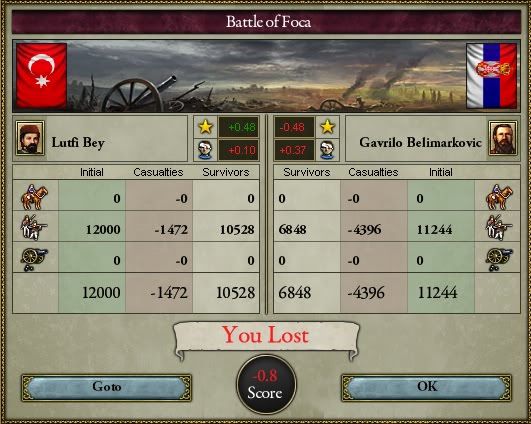
On September 19 and October 4 the Serb army managed to defeat two small enemy contingents in Niksic and Pljevlja, but otherwise the forces were ordered to regroup at Cetijne, where the newly constructed fort provided good defences. Slowly reinforcements arrived and the army would soon be ready for action again.
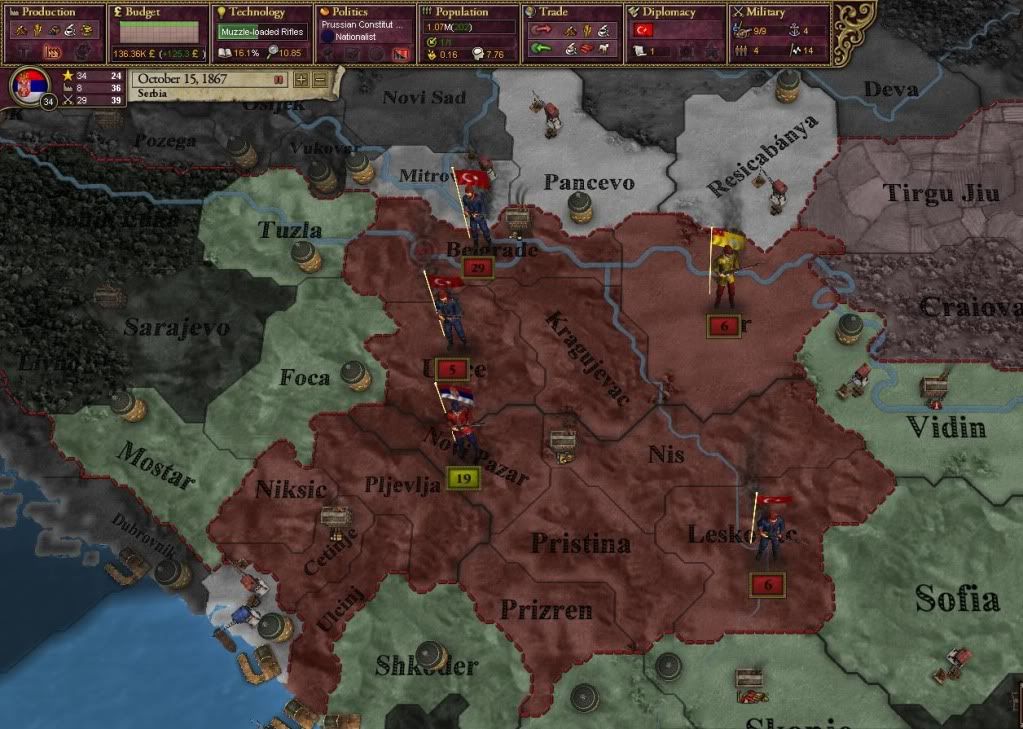
By early October the initiative was obviously on the Turks side, busy laying siege to a number of provinces, notably Belgrade. General Belimarkovic and the entire Serb army remained holed up in the mountains, hoping for assistance from the Russians.
And the Russians, together with Krakow, had been busy, defeating the enemy on both fronts. Their forces were poised to enter Moldova and the empire itself by end of 1867.
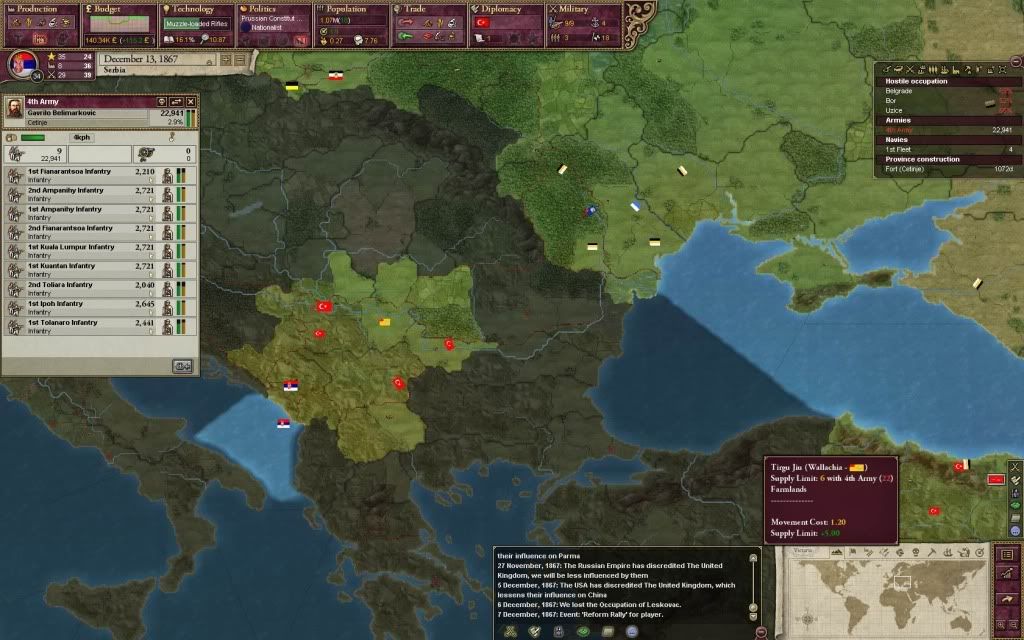
Yet by end of January reports started to come in; Uzice and Belgrade both surrendered on January 21, Bor and Leskovac followed suit over the next few weeks. Eventually enemy troops began to move eastwards as the Russians moved down the west coast of the Black Sea.
By the end of February the main enemy force consisted of 9 brigades in Kragaievac, while a single brigade occupied Novi Pazar. Feeling confident Belimarkovic started the first 1868 counteroffensive, securing a small victory in Novi Pazar.
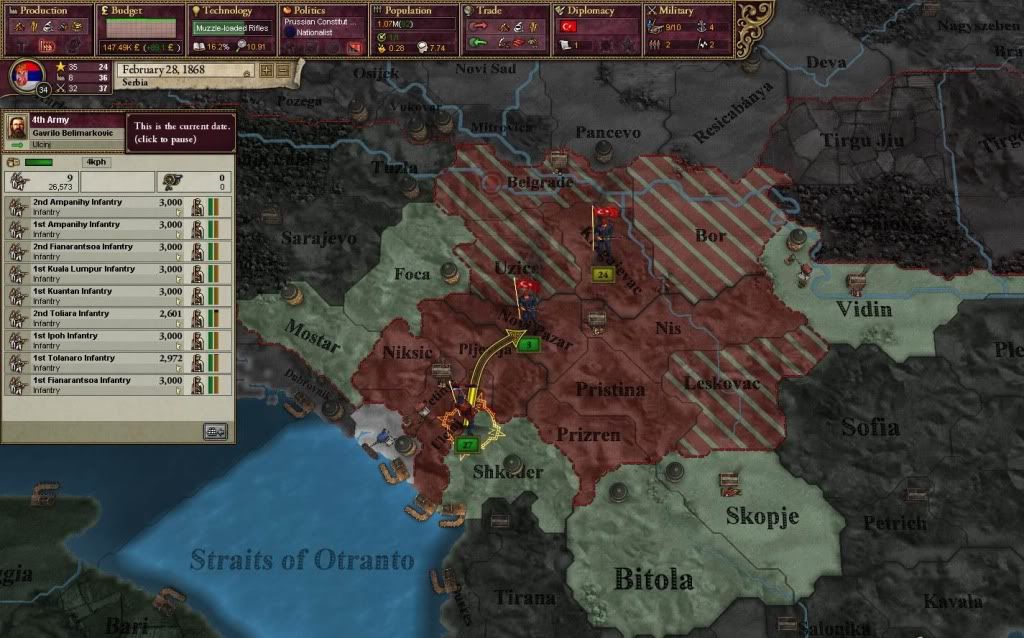
Hereafter the Ottoman forces pulled out of Serbia and were sent back to counter the Russians. This gave the Serbs the opportunity to take back the occupied provinces and begin to besiege Bosnia again.
By early October Serbia was once again free and Bosnia was slowly coming under Serb control. Moldova was already fully occupied by the Russians and Wallachia would not last long neither. Around the same time Serb infantry was receiving the new muzzle-loaded rifles, boosting morale and the fighting capabilities altogether.
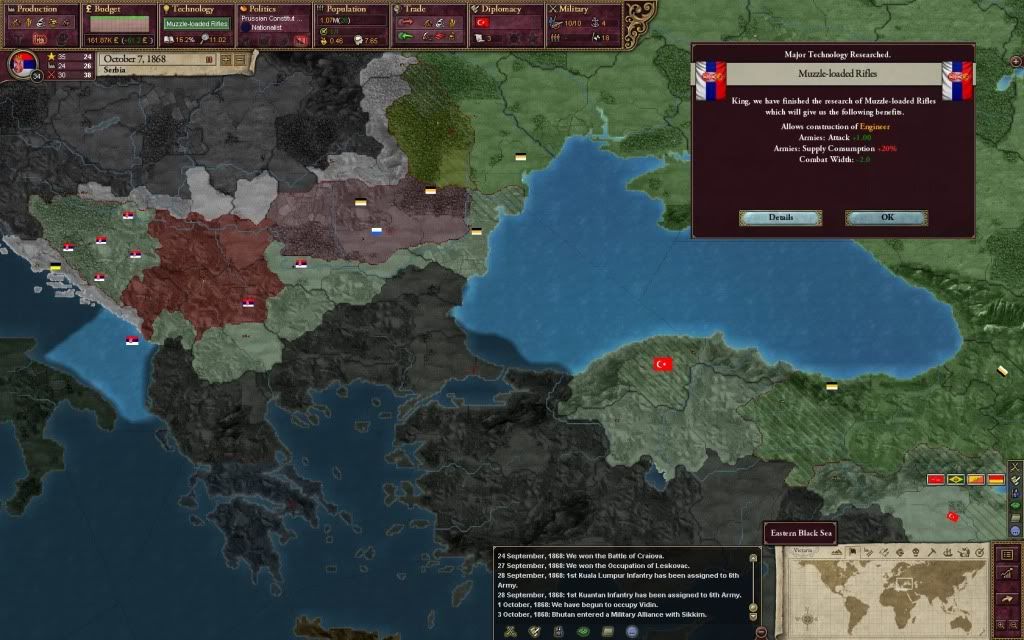
Benefitting from the good results on the battlefield a coalition of socialists and liberals secured the majority in the Upper House and shortly hereafter introduced political reforms. At the same time, the Russians decided to lay claims to the Malatya region.

During the following months no major engagements took place as the Serb-Russian alliance began to take control of Ottoman provinces. Things were looking good, until a massive uprising of anarcho-liberals happened across most of Russia. This had the unfortunate effect that a number of brigades were called back home to deal with the civil unrest.

In May Austria concede defeat to Prussia, resulting in Bohemia coming under Prussian control, which prompted the Hungarian nobles to call for greater autonomy – the Austrian-Hungarian monarchy was a reality. The Hawks in Belgrade were suddenly very loud, having long been advocates of joining the Prussians in an effort to take back Slavonia. Yet Austria-Hungary still remained the most powerful regional power, only second to France. Even Russia could not muster the same military muscle as Vienna could. Any hopes of expanding northwards would still be some time into the future.
Seizing on the Russian retreat, the Ottomans launched a surprise counter-offensive, trapping and destroying a smaller Serb army in Ruse. Luckily Omar Pasha, leading app. 40.000 men did not further seek to engage the spread out Serb forces but concentrated on taking back Ruse.
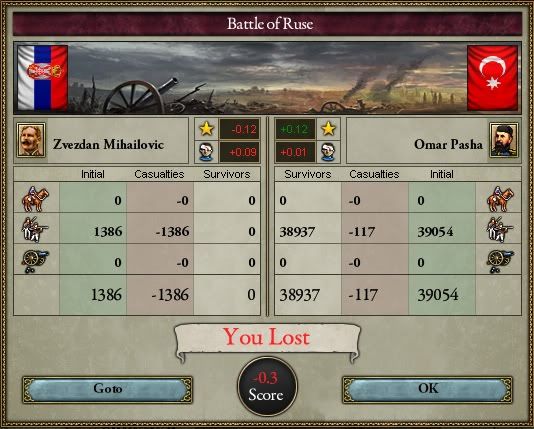
The failure to aggressively pursue the divided Serb forces would turn out to be a major mistake, as it would allow Serbia to continue it’s Fabien strategy of taking control of as many provinces as possible while avoiding the decisive showdown.
By late summer all of Serbia, North Macedonia was firmly controlled by Serbia, while Albania and the Greek-ethnic provinces of Macedonia were under assault.
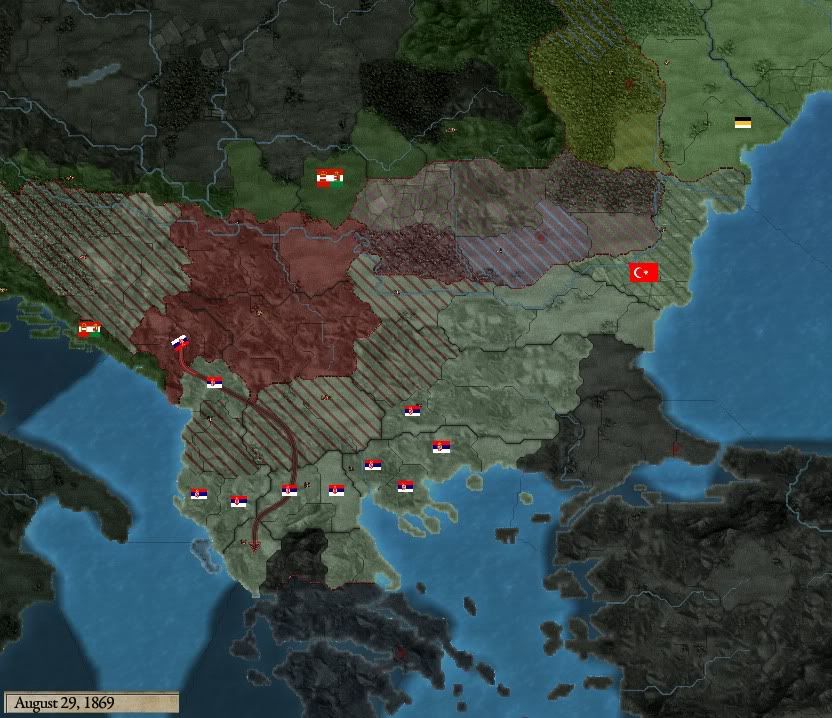
One by one the enemy provinces surrendered and soon only Thrace and the western part of Anatolia were still controlled by Istanbul. It would soon just be a matter of time before the enemy’s will to continue to fight would break.
Plans were already underway for celebrating Bosnia’s annexation, and victory seemed assured as the terrible 1860’s gave way to a new decade. And victory did finally come on January 18 1970, but the taste was bitter and there was absolutely nothing to celebrate. The Russians had once again dealt a severe blow to Serb dreams of grandeur……..
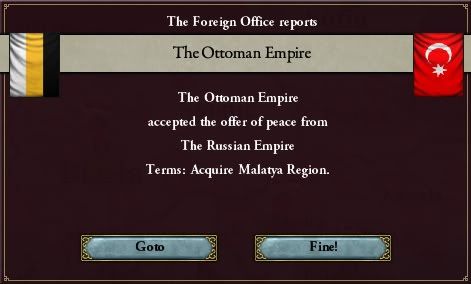
Following the declaration of war, the Serb allies of Russia and Krakow both responded favourably to the call for help. Consequently Russia would become the leader of the alliance against the Ottoman Empire, who in turn could rely on their satellite states Moldova and Wallachia.
At the outbreak of the war for the liberation of Bosnia, the Serb army had deployed 33.000 men in two armies; the main force lead by general Belimarkovic as objective to defend Serb territory from the Ottomans, while a smaller force commanded by general Rasic would move to against defending forces in Bosnia before laying siege. The enemy would was expected to have app 30 brigades available, although many of these were already committed in the Russian invasion. However, only a few days into the war the Ottoman Empire called for a general mobilisation, effectively doubling their numbers.
Initially the Serb forces won the first few skirmishes against newly raised units and not yet fully operational. However on September Lufti Bey defeated the main Serb force in the Battle of Foca, resulting in over 4000 casualties (a third of the initial force). Two other minor defeats followed and it was becoming evident that once again there was a significant gap in the quality of the troops and equipment between the two sides.

On September 19 and October 4 the Serb army managed to defeat two small enemy contingents in Niksic and Pljevlja, but otherwise the forces were ordered to regroup at Cetijne, where the newly constructed fort provided good defences. Slowly reinforcements arrived and the army would soon be ready for action again.

By early October the initiative was obviously on the Turks side, busy laying siege to a number of provinces, notably Belgrade. General Belimarkovic and the entire Serb army remained holed up in the mountains, hoping for assistance from the Russians.
And the Russians, together with Krakow, had been busy, defeating the enemy on both fronts. Their forces were poised to enter Moldova and the empire itself by end of 1867.

Yet by end of January reports started to come in; Uzice and Belgrade both surrendered on January 21, Bor and Leskovac followed suit over the next few weeks. Eventually enemy troops began to move eastwards as the Russians moved down the west coast of the Black Sea.
By the end of February the main enemy force consisted of 9 brigades in Kragaievac, while a single brigade occupied Novi Pazar. Feeling confident Belimarkovic started the first 1868 counteroffensive, securing a small victory in Novi Pazar.

Hereafter the Ottoman forces pulled out of Serbia and were sent back to counter the Russians. This gave the Serbs the opportunity to take back the occupied provinces and begin to besiege Bosnia again.
By early October Serbia was once again free and Bosnia was slowly coming under Serb control. Moldova was already fully occupied by the Russians and Wallachia would not last long neither. Around the same time Serb infantry was receiving the new muzzle-loaded rifles, boosting morale and the fighting capabilities altogether.

Benefitting from the good results on the battlefield a coalition of socialists and liberals secured the majority in the Upper House and shortly hereafter introduced political reforms. At the same time, the Russians decided to lay claims to the Malatya region.

During the following months no major engagements took place as the Serb-Russian alliance began to take control of Ottoman provinces. Things were looking good, until a massive uprising of anarcho-liberals happened across most of Russia. This had the unfortunate effect that a number of brigades were called back home to deal with the civil unrest.

In May Austria concede defeat to Prussia, resulting in Bohemia coming under Prussian control, which prompted the Hungarian nobles to call for greater autonomy – the Austrian-Hungarian monarchy was a reality. The Hawks in Belgrade were suddenly very loud, having long been advocates of joining the Prussians in an effort to take back Slavonia. Yet Austria-Hungary still remained the most powerful regional power, only second to France. Even Russia could not muster the same military muscle as Vienna could. Any hopes of expanding northwards would still be some time into the future.
Seizing on the Russian retreat, the Ottomans launched a surprise counter-offensive, trapping and destroying a smaller Serb army in Ruse. Luckily Omar Pasha, leading app. 40.000 men did not further seek to engage the spread out Serb forces but concentrated on taking back Ruse.

The failure to aggressively pursue the divided Serb forces would turn out to be a major mistake, as it would allow Serbia to continue it’s Fabien strategy of taking control of as many provinces as possible while avoiding the decisive showdown.
By late summer all of Serbia, North Macedonia was firmly controlled by Serbia, while Albania and the Greek-ethnic provinces of Macedonia were under assault.

One by one the enemy provinces surrendered and soon only Thrace and the western part of Anatolia were still controlled by Istanbul. It would soon just be a matter of time before the enemy’s will to continue to fight would break.
Plans were already underway for celebrating Bosnia’s annexation, and victory seemed assured as the terrible 1860’s gave way to a new decade. And victory did finally come on January 18 1970, but the taste was bitter and there was absolutely nothing to celebrate. The Russians had once again dealt a severe blow to Serb dreams of grandeur……..

Last edited:
Amazing story!! Sorry for the goddamn Russians...and unbelievable that prussia lost to Austria  Still I am very interested how this story ends....Keep it up
Still I am very interested how this story ends....Keep it up
Never call in an AI GP to one of your wars. They'll stab you in the back every time! I find it better to wait until they're heavily engaged in a war with your enemy, then launch your own independent war to gain your goals while the enemy is still engaged with the other GP. The secret is to fight for limited goals and get out of the war as soon as you can before the other war ends and your enemy can reorganize their army.
Amazing story!! Sorry for the goddamn Russians...and unbelievable that prussia lost to AustriaStill I am very interested how this story ends....Keep it up

Well thank you kind sir!
Just cant trust those Russians
Indeed. Maybe third time's a charm?
Never call in an AI GP to one of your wars. They'll stab you in the back every time! I find it better to wait until they're heavily engaged in a war with your enemy, then launch your own independent war to gain your goals while the enemy is still engaged with the other GP. The secret is to fight for limited goals and get out of the war as soon as you can before the other war ends and your enemy can reorganize their army.
You are probably right, as long as they (Russia) will initiate their own war against OE. Which hasn't been the case since the beginning of the game
Damn! Those back-stabbing Russians!
Have you tried an alliance with Greece? They may be small but they too want to carve land out of the Ottos...
Have you tried an alliance with Greece? They may be small but they too want to carve land out of the Ottos...
Damn! Those back-stabbing Russians!
Have you tried an alliance with Greece? They may be small but they too want to carve land out of the Ottos...
Yes, they're not interested. Neither is anyone else. I suspect my high infamy is acting as a deterrent.
This is great. I want to try a Serbia -> Yugoslavia game one day, but I need more experience. This AAR is a great help - I hadn't thought of the Montenegro gambit, but it seems like a reasonabe thing to do.
The map would look so much better if you had Bosnia. I'm confident that you'll get it - the Ottomans are weakened by every Russo-Turkish war. Best of luck!
The map would look so much better if you had Bosnia. I'm confident that you'll get it - the Ottomans are weakened by every Russo-Turkish war. Best of luck!
This AAR is a great help - I hadn't thought of the Montenegro gambit, but it seems like a reasonabe thing to do.
I don't think it was actually a great thing to do more making the most of a bad situation after the Russians totally failed to help destroy the Ottomans.
I don't think it was actually a great thing to do more making the most of a bad situation after the Russians totally failed to help destroy the Ottomans.
Correct, I wouldn't annex Montenegro (not the Ottoman Montenegro that is) again as the 20 infamy points aren't worth it. If/when Yugoslavia is created it'll be included automatically.
Would you have been able to make a separate peace once Russia added war goals? Or did you need more war score.
The World in 1870
North America is divided between the Union and Confederation, while Mexico still controls the west coast. The borders in South America are pretty much as they were in 1836.
Both the NGF and Austria are fighting to determine who is the dominating German power, Italy is still divided, while the Ottomans have ceded parts of Anatolia to Russia.
Egypt is surprisingly fairly intact, and Africa is yet to be colonized. Even Algeria still exists, albeit in a smaller and landlocked version.
In the East, the UK has taken a bit out of China and other surrounding nations.
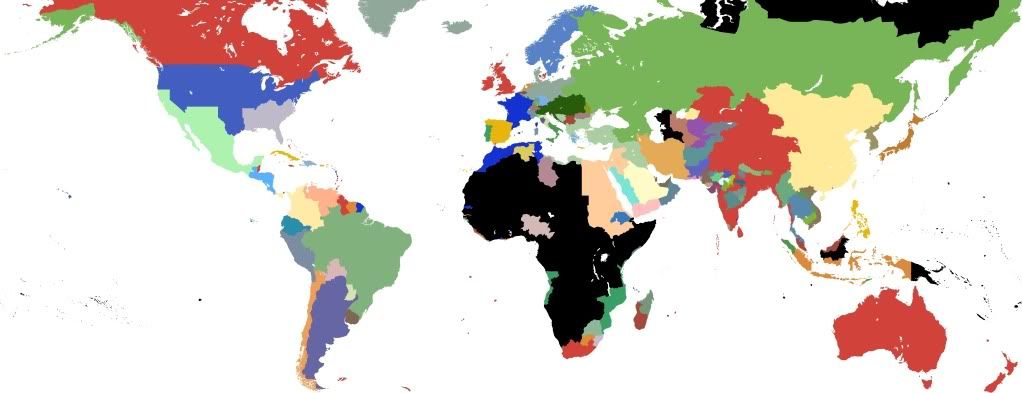
Behold the glorious Principality of Serbia, including its African and Asian possessions.

North America is divided between the Union and Confederation, while Mexico still controls the west coast. The borders in South America are pretty much as they were in 1836.
Both the NGF and Austria are fighting to determine who is the dominating German power, Italy is still divided, while the Ottomans have ceded parts of Anatolia to Russia.
Egypt is surprisingly fairly intact, and Africa is yet to be colonized. Even Algeria still exists, albeit in a smaller and landlocked version.
In the East, the UK has taken a bit out of China and other surrounding nations.

Behold the glorious Principality of Serbia, including its African and Asian possessions.

Last edited:
Episode Six - Consolidation and Consternation (1870-1876)
Peace once again prevailed across much of the world for a short time, until the 2nd American Civil War broke out in May of 1871. Sweden rose to the rank of Great Power, displacing the Two Sicilies, nothing which did interest the good citizens of Serbia very much.
Efforts were still made in developing better weapons and eventually the breech-loaded rifle became the standard firearm of the Serb armed forces. A new crack infantry unit, called Guards, was also being trained, exclusively made up of the most loyal and best soldiers. However critical components were hard to source from the world market prolonging the training time.
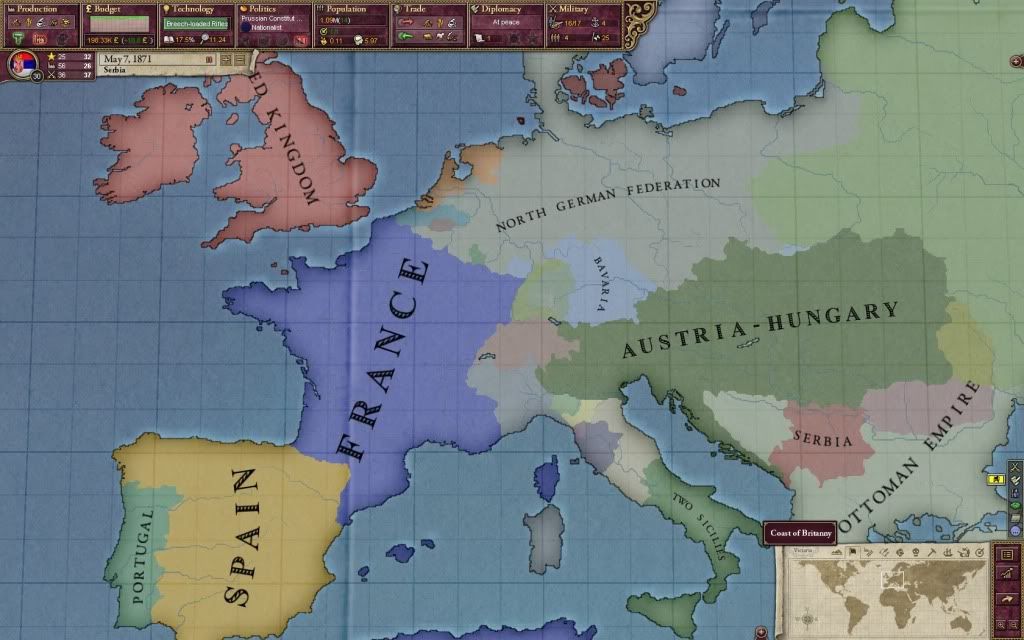
Map of Europe, May 1871. Note the size and shape of the Netherlands, Flanders and Belgium (Bruxelles), and France extending into Spain.
The new equipment would quickly be put to the test as the third Serb Asian conquest was initiated, this time aimed at the Sultanate of Atjeh. By September most of the small nation was under Serb control and the last engagement in Banda Aceh would result in a devastating victory.
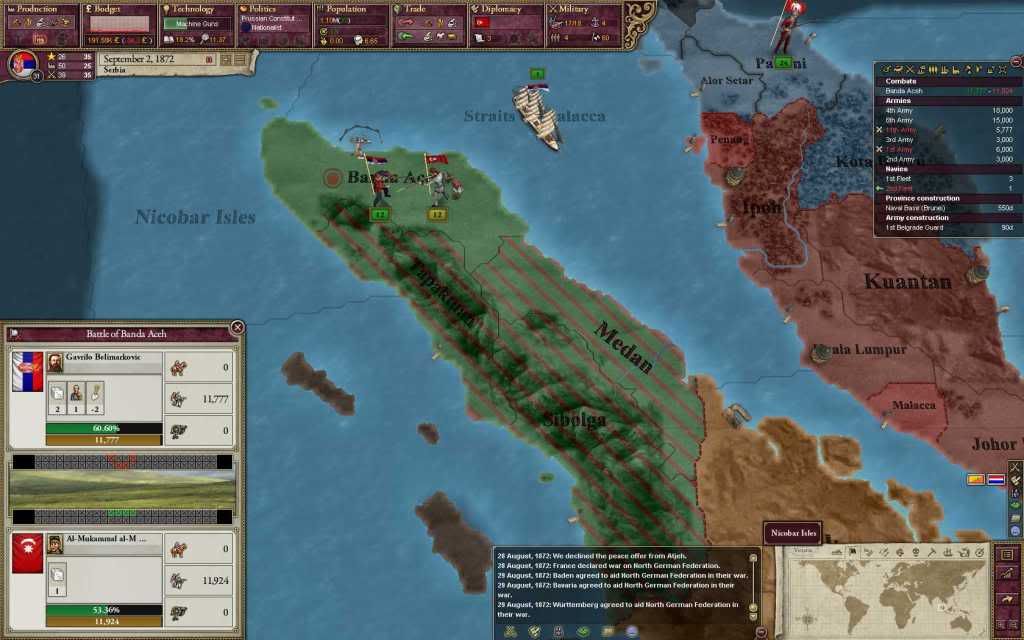
Atjeh troops were no match against superior Serb forces at the Battle of Banda Aceh
Probably inspired by the Serb aggression, France began the French conquest of North German Wallonia against the North German Federation and it’s allies Württemberg, Bavaria and Baden, Europe was once again embroiled in a large-scale war. In North America the AWCII came to a quick end as both sides agreed to a white peace in December 1872.
As the last phase of the conquest of Atjeh was coming to an end, the envious Dutch decided to begin their own war against Serbia, with the intention of liberating Montenegro!
To make matters worse, both of Serbia’s allies refused to get involved. Serbia was once again on it’s own. The biggest challenge was the lack of a proper navy – the Serb only had a handful of transport vessels, whereas the Dutch both had capital ships and numerous escorts.
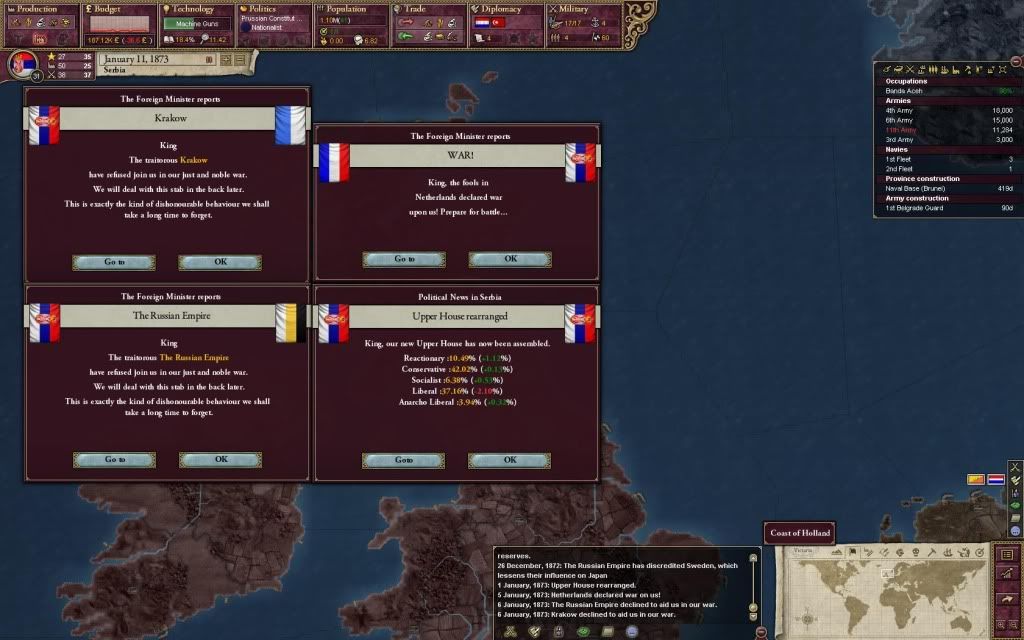
Immediately the troops in Serbia were deployed at the coast anticipating an invasion on Montenegro. And very quickly an invasion fleet did materialize outside Ulcijn, but oddly enough no Dutch troops would disembark – instead the invasion was called off, probably discouraged by the display of Serb force (all the 36.000 men available. This was at the very least a moral victory.
In Asia the situation was not quite so encouraging. The Serb Asian army of 3 brigades were facing an enemy at least 4 times their size. Rather than trying to check the Dutch advance into Atjeh the troops were in haste evacuated from the island back to Johore. The Dutch navy was still not active but that would not last for long.
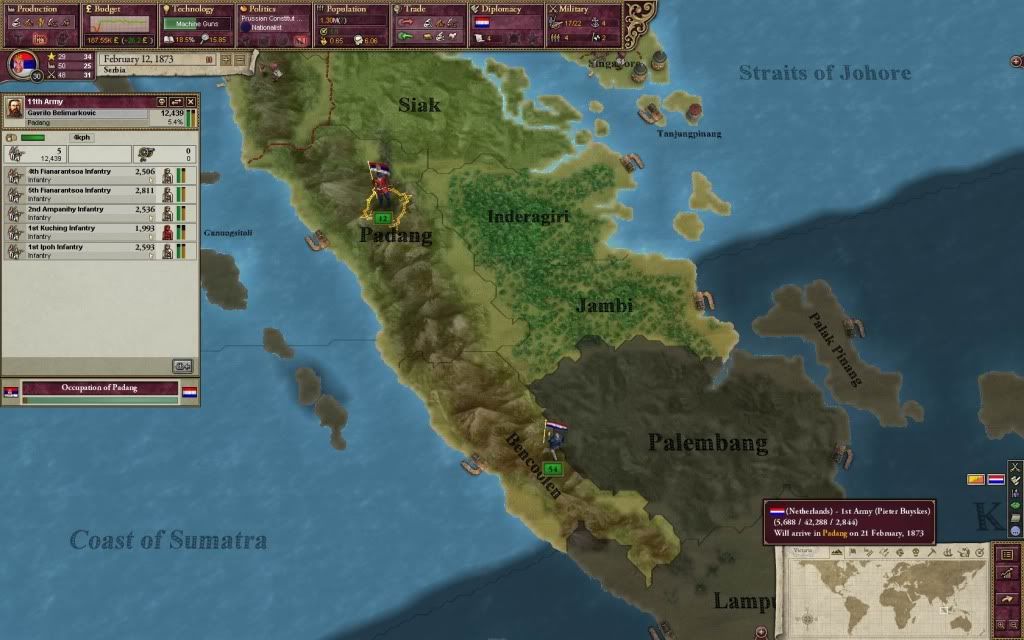
The ensuing two years Serb troops were playing cat and mouse with the Dutch, the former refusing to fight the superior enemy and instead occupying Dutch provinces. All of Atjeh and Johore finally came under enemy control, however most of the enemy territory, save Java, had fallen to the Serbs. Eventually the Dutch grew tired and proposed a White Peace. Serbia graciously accepted.
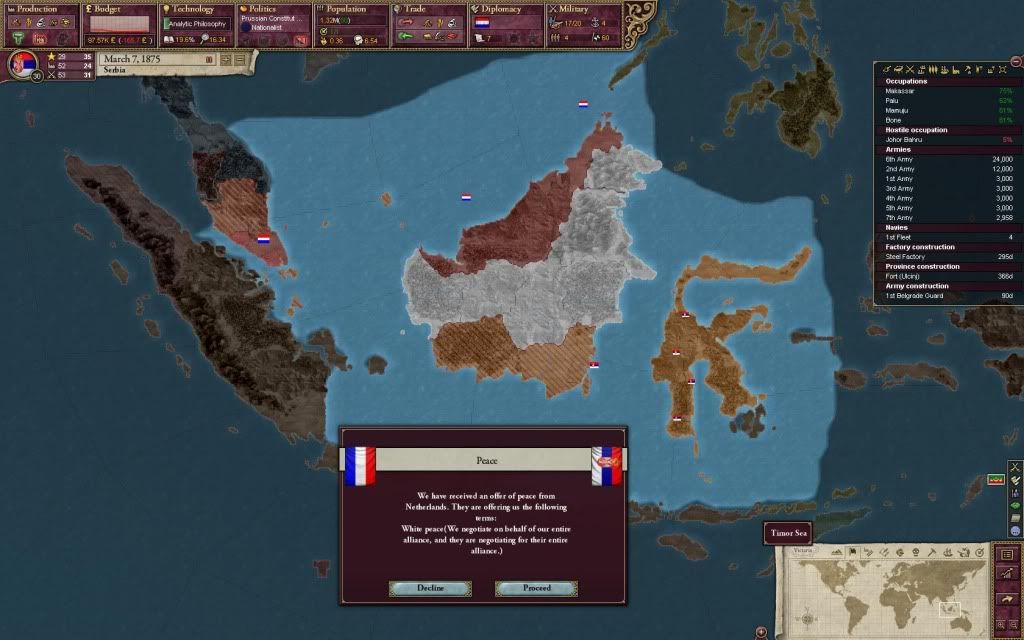
In the meantime, the NGF had surrendered, handing over Wallonia to France. Sensing weakness both Austria-Hungary and Russia quickly lunged themselves at the Germans. The war would not last long and Austria-Hungary would eventually take back Bohemia.
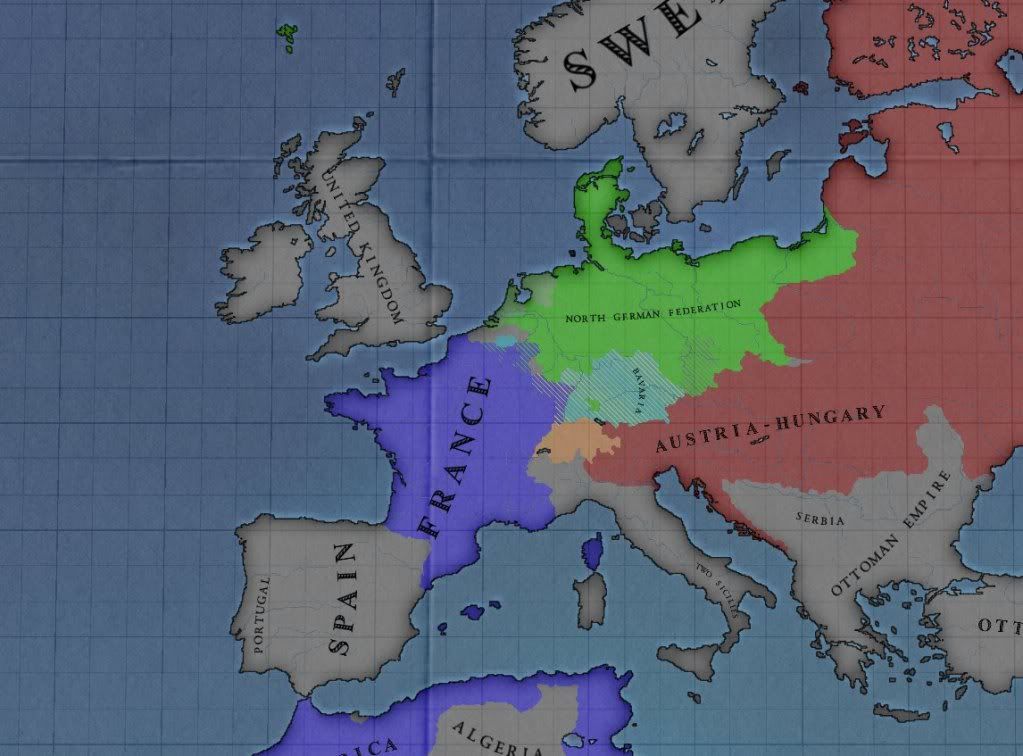
Scientists, industrialists and academics were jointly making advances in modernizing the armed forces, and soon Serbia would be able to produce ammunition and explosives on its own.
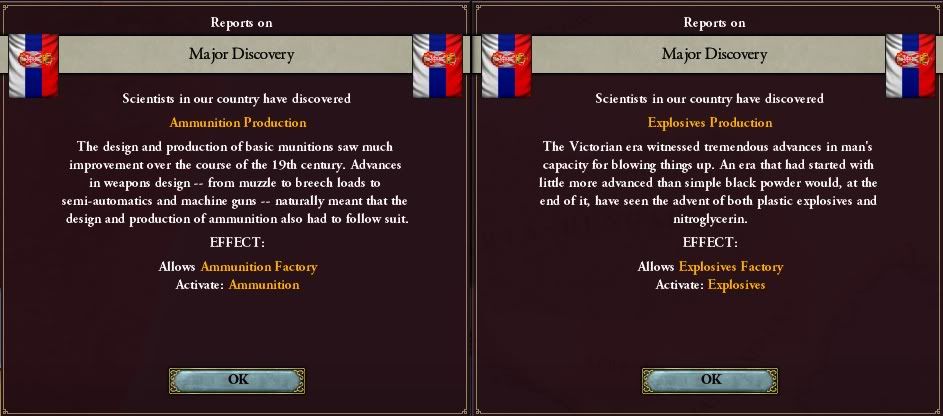
Although mastering the technology few capitalists would invest in the new industries for years to come
State-subsidised efforts to promote major technological breakthroughs had recently been limited to the army and the manufacturing industries, whereas general culture to improve education had previously been the focus. Both the commerce and navy branches had received only very little attention.
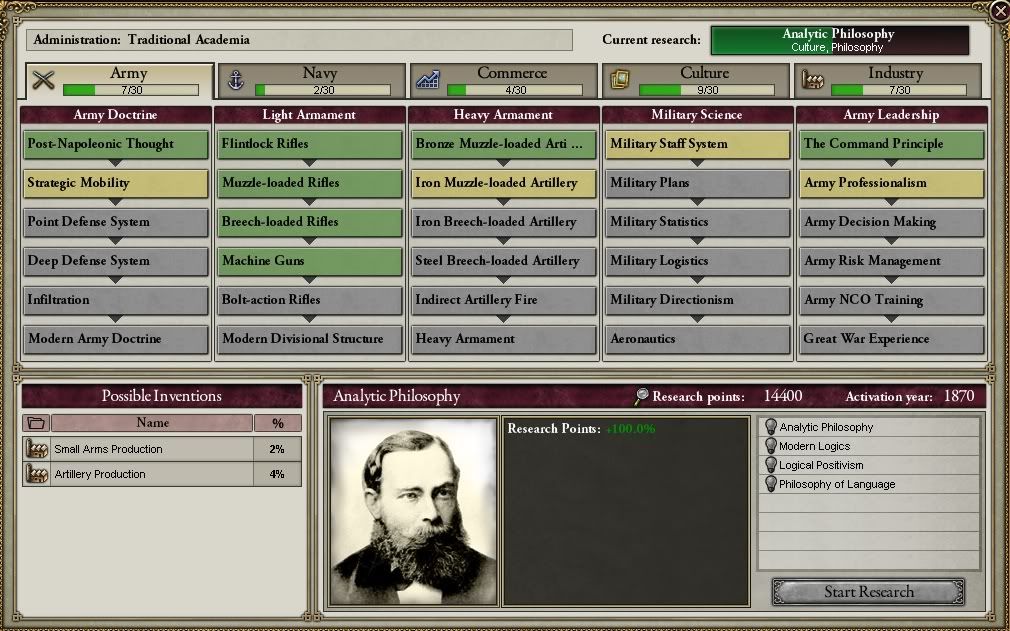
Bu 1876 it was time to take stock of the situation, now 40 years into the grand plans originally hatched by Prince Aleksandar. Serbia was a different country by now with a population 6 times that of 1836. Of which half were from the colonies, although Serbs still remained the main ethnic group.
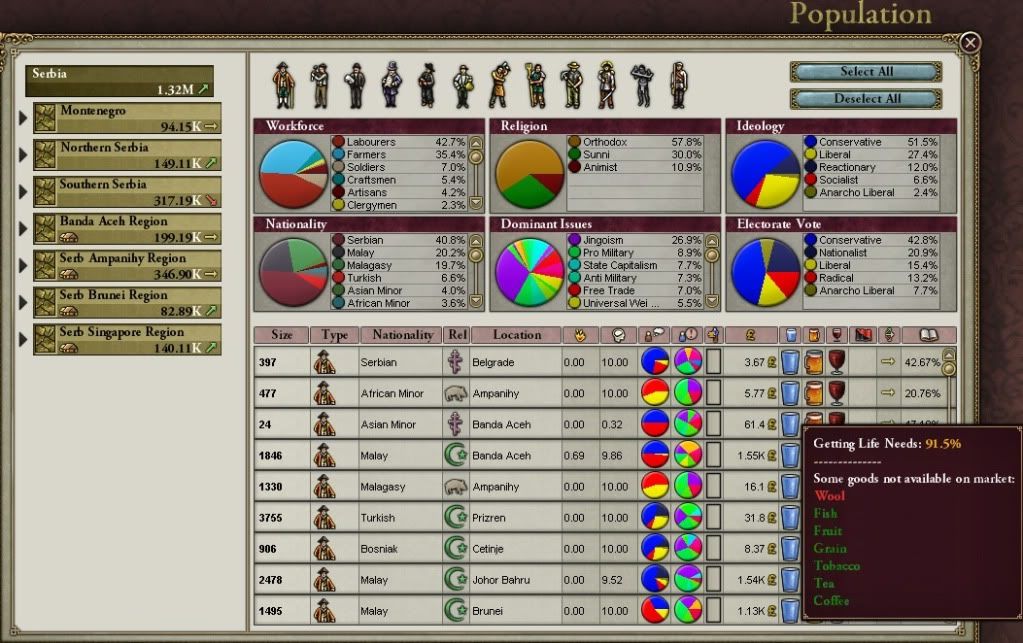
Wool remained a difficult good to procure, resulting a reduce quality of life for all strata of society
The most profitable provinces were colonial, depending on exports of coffee, tea, fruit and coal. Factories were still an insignificant part of the overall profit and a small employer. As Serbia was not part of any major powers sphere of influence, the economy remained isolated. Especially during wartime exports plummeted and access to foreign goods became very difficult.

For some time the the colonial governor of Ampanihy, southern part of Madagascar, had been advocating expansion northwards. It would only make sense to unite the entire island, providing access to abundant resources, but of course also allowing the natives of the north to become civilized and literate modern citizens!
It seemed the French had the exact same thought and one suddenly one morning the Tricolore flew over towns and cities. Any hopes of further African possessions would have to be on the continent itself.
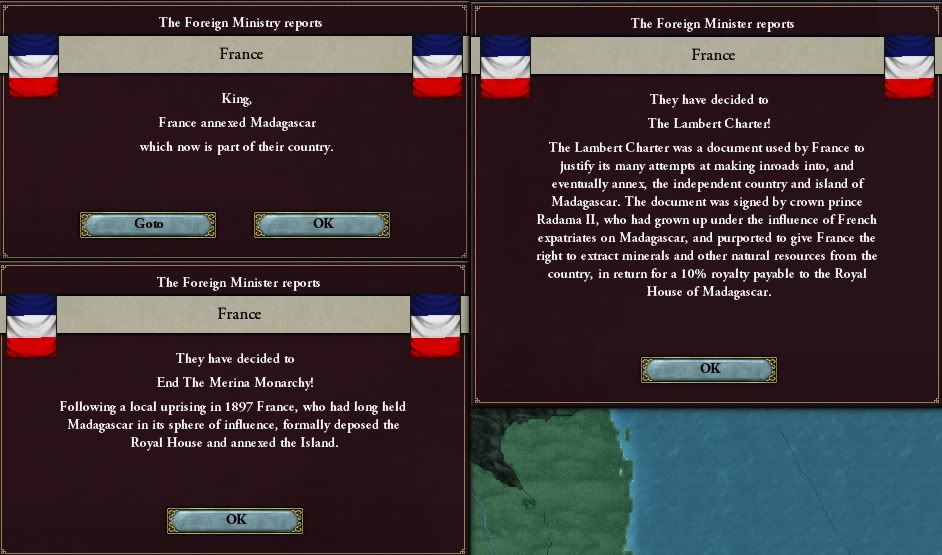
New neighbours moving in
On mainland Africa recent discoveries allowed Europeans to move inlands, and slowly the southwestern and southern part of this vast continent were becoming colonized. However Serbia was far from capable and willing to pursue such imperialistic endeavours, both from a political and technological point of view.

After repeated futile attempts of signing alliances with both Russia and Austria-Hungary, Serbia remained independent. Nor were any of the 8 great powers seemingly interested in adding Serbia to their spheres of influence. Serbia had to count on herself economically, politically and militarily.
Consequently campaigns had been ongoing for years to attract new recruits and results where showing: by early 1876 the Serb army counted over 20 brigades, mainly made up of colonial troops. Many of these troops had been transferred back to Serbia, in anticipation of further aggressions. A strategic move that would prove crucial as a formal declaration of war was soon delivered.
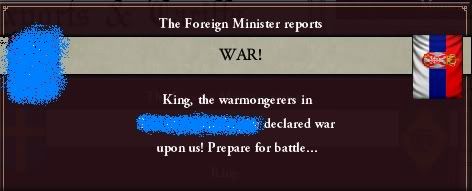
Yet who had the audacity to do so?
Peace once again prevailed across much of the world for a short time, until the 2nd American Civil War broke out in May of 1871. Sweden rose to the rank of Great Power, displacing the Two Sicilies, nothing which did interest the good citizens of Serbia very much.
Efforts were still made in developing better weapons and eventually the breech-loaded rifle became the standard firearm of the Serb armed forces. A new crack infantry unit, called Guards, was also being trained, exclusively made up of the most loyal and best soldiers. However critical components were hard to source from the world market prolonging the training time.

Map of Europe, May 1871. Note the size and shape of the Netherlands, Flanders and Belgium (Bruxelles), and France extending into Spain.
The new equipment would quickly be put to the test as the third Serb Asian conquest was initiated, this time aimed at the Sultanate of Atjeh. By September most of the small nation was under Serb control and the last engagement in Banda Aceh would result in a devastating victory.

Atjeh troops were no match against superior Serb forces at the Battle of Banda Aceh
Probably inspired by the Serb aggression, France began the French conquest of North German Wallonia against the North German Federation and it’s allies Württemberg, Bavaria and Baden, Europe was once again embroiled in a large-scale war. In North America the AWCII came to a quick end as both sides agreed to a white peace in December 1872.
As the last phase of the conquest of Atjeh was coming to an end, the envious Dutch decided to begin their own war against Serbia, with the intention of liberating Montenegro!
To make matters worse, both of Serbia’s allies refused to get involved. Serbia was once again on it’s own. The biggest challenge was the lack of a proper navy – the Serb only had a handful of transport vessels, whereas the Dutch both had capital ships and numerous escorts.

Immediately the troops in Serbia were deployed at the coast anticipating an invasion on Montenegro. And very quickly an invasion fleet did materialize outside Ulcijn, but oddly enough no Dutch troops would disembark – instead the invasion was called off, probably discouraged by the display of Serb force (all the 36.000 men available. This was at the very least a moral victory.
In Asia the situation was not quite so encouraging. The Serb Asian army of 3 brigades were facing an enemy at least 4 times their size. Rather than trying to check the Dutch advance into Atjeh the troops were in haste evacuated from the island back to Johore. The Dutch navy was still not active but that would not last for long.

The ensuing two years Serb troops were playing cat and mouse with the Dutch, the former refusing to fight the superior enemy and instead occupying Dutch provinces. All of Atjeh and Johore finally came under enemy control, however most of the enemy territory, save Java, had fallen to the Serbs. Eventually the Dutch grew tired and proposed a White Peace. Serbia graciously accepted.

In the meantime, the NGF had surrendered, handing over Wallonia to France. Sensing weakness both Austria-Hungary and Russia quickly lunged themselves at the Germans. The war would not last long and Austria-Hungary would eventually take back Bohemia.

Scientists, industrialists and academics were jointly making advances in modernizing the armed forces, and soon Serbia would be able to produce ammunition and explosives on its own.

Although mastering the technology few capitalists would invest in the new industries for years to come
State-subsidised efforts to promote major technological breakthroughs had recently been limited to the army and the manufacturing industries, whereas general culture to improve education had previously been the focus. Both the commerce and navy branches had received only very little attention.

Bu 1876 it was time to take stock of the situation, now 40 years into the grand plans originally hatched by Prince Aleksandar. Serbia was a different country by now with a population 6 times that of 1836. Of which half were from the colonies, although Serbs still remained the main ethnic group.

Wool remained a difficult good to procure, resulting a reduce quality of life for all strata of society
The most profitable provinces were colonial, depending on exports of coffee, tea, fruit and coal. Factories were still an insignificant part of the overall profit and a small employer. As Serbia was not part of any major powers sphere of influence, the economy remained isolated. Especially during wartime exports plummeted and access to foreign goods became very difficult.

For some time the the colonial governor of Ampanihy, southern part of Madagascar, had been advocating expansion northwards. It would only make sense to unite the entire island, providing access to abundant resources, but of course also allowing the natives of the north to become civilized and literate modern citizens!
It seemed the French had the exact same thought and one suddenly one morning the Tricolore flew over towns and cities. Any hopes of further African possessions would have to be on the continent itself.

New neighbours moving in
On mainland Africa recent discoveries allowed Europeans to move inlands, and slowly the southwestern and southern part of this vast continent were becoming colonized. However Serbia was far from capable and willing to pursue such imperialistic endeavours, both from a political and technological point of view.

After repeated futile attempts of signing alliances with both Russia and Austria-Hungary, Serbia remained independent. Nor were any of the 8 great powers seemingly interested in adding Serbia to their spheres of influence. Serbia had to count on herself economically, politically and militarily.
Consequently campaigns had been ongoing for years to attract new recruits and results where showing: by early 1876 the Serb army counted over 20 brigades, mainly made up of colonial troops. Many of these troops had been transferred back to Serbia, in anticipation of further aggressions. A strategic move that would prove crucial as a formal declaration of war was soon delivered.

Yet who had the audacity to do so?
Last edited:

